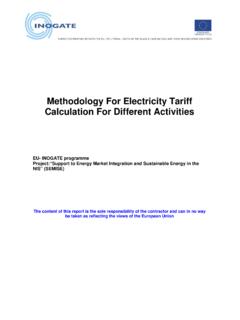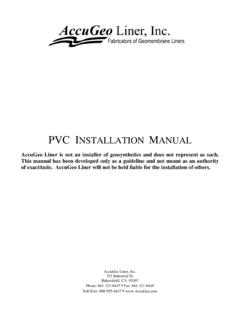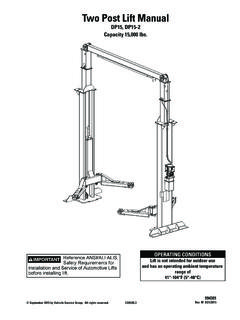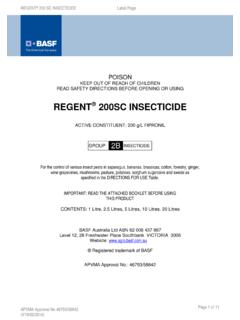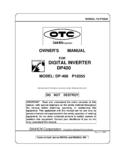Transcription of Technical Seminar for Cathodic Protection to …
1 Technical Seminar for Cathodic Protection to GOGC Design Unit Specialists Dr. Nick Kioupis, Cathodic & Lightning Protection Section Head, DESFA CP Design Criteria Pre-requisites for the application of Cathodic Protection Electrical continuity Electrical isolation Lightning and overvoltage Protection Coating Selection of pipe trench backfill material Buried casings for pipelines Equipment for the reduction of interference Equipment for the mitigation of interference Electrical Continuity Low longitudinal resistance of the pipeline and the components which may increase the longitudinal resistance of the structure shall be short-circuited. On non-welded pipelines, the electrical continuity shall be achieved on the length to be protected by the installation of permanent bonds across the high resistance mechanical connectors using reliable bond attachment methods.
2 The continuity of non-welded pipelines shall be checked by carrying out resistance and potential measurements When necessary, bonding may be carried out across isolating devices for measurement or other purposes. If it is necessary that electrical continuity be established permanently, this bonding should be done in a test station. Electrical Isolation Locations Requirements for isolating joints Internal corrosion risks at isolating joints Contacts between metallic structures Electrical earthing system Electrical Isolation Metallic contacts or resistive contacts between the pipeline and other structures, or direct connection to earthing systems, should be avoided; otherwise, the corrosion risk can be increased. For this reason, pipelines should be electrically isolated from compressor stations, pump stations, wellsites, offshore pipelines and structures, terminals and processing facilities.
3 Isolation should be achieved by installation of monolithic (mono-bloc) isolation joints, isolating flange kits or non conductive pipe sections. If electrical isolation is not possible, then the Cathodic Protection design shall provide for sufficient current and effective current distribution to ensure that the pipeline is cathodically protected without adverse effect on other structures. Monolithic (monoblock) IJ DESCRIPTION ( ) PIN BRAZING (O-RING) Schematic of insulating flange Isolating flange with Ex-proof spark gap (U50Hz=1kV, U1/50 s= , surge current =100kA) flange, nut, ring, 4.
4 Insulator sleeve, 5. Insulator disc, 6. Steel disc 7. Isolating sealing gasket, 8. Spark gap Electrical Isolation - Locations between pipeline sections consisting of different metallic materials; at the extremities of the pipeline; at significant changes in electrolyte resistivity; on pipelines requiring different Cathodic Protection systems; on pipelines with different current density requirements; in areas influenced by stray currents, or telluric currents; on some pipeline networks to facilitate the Cathodic Protection maintenance or measurements; at interfaces with unprotected structures or earthed equipment at the interface with customer facilities Requirements for isolating joints The mechanical design, materials, dimensions and construction of the isolating joints shall meet the requirements of ISO 13623, EN 14161, EN 1594 or EN 12007-3, as applicable.
5 Isolating joints should be electrically tested before installation. Requirements for isolating joints Monobloc isolation joints should be used wherever possible. They may be installed above-ground, in a pit (where local safety regulations permit) or buried. Installing the isolation joint above ground provides the advantage of easier visual, electrical and ultrasonic inspection. On the other hand, buried isolating joints are less exposed to mechanical or fire hazards, voluntary or involuntary damage and can prevent the product inside the pipeline from freezing (sometimes referred to as "frost-proof grounding"). Installing an isolating joint in a pit provides the advantages of a buried isolation joint but with the added risk of gas entrapment. For this reason, local regulations can prevent installation of an isolation joint in a pit. Requirements for isolating joints When a pipeline is connected to above-ground facilities, an above-ground isolating joint ensures that Cathodic Protection is applied to the entire buried section.
6 If the isolation joint is buried, then the pipeline operator shall take additional measures for corrosion Protection of the section of the pipeline that is isolated from the main Cathodic Protection system. If multiphase fluids containing a significant percentage of water are transported in the pipeline, installation of the isolating joint on a vertical or angled transition section may be considered to prevent a continuous water phase inside the pipeline becoming the source of internal corrosion Buried isolation joints shall be externally coated with materials that are compatible with the coating applied to the pipeline. Requirements for isolating flanges Isolating flanges are subject to degradation by atmospheric weathering, dirt and moisture ingress and shall be protected against ingress of dirt and moisture by the use of flange protectors or viscoelastic compounds.
7 A major cause of failure of isolating flanges is poor installation techniques. To reduce this risk, the manufacturer s instructions should be followed or factory preinstalled kits can be utilized. Requirements for isolating flanges Principal installation errors are: over-tightening of the flange bolts (isolating flanges require a lower tightening torque than flanges without isolating gaskets); incorrect alignment of flange faces; Improper surface preparation of flange faces Requirements for isolating joints withstand service conditions ( transported medium, temperature, pressure, mechanical stress) appropriate dielectric strength. mechanical ( flexural and tensile strength, etc.), isolation efficiency water absorption. Requirements for isolating joints Isolating joints shall be installed in such a manner as to eliminate the risk of accidental shorting.
8 To avoid damage from high voltages due to lightning strikes or fault currents caused by electric power lines, protective devices shall be considered ( appropriate isolating spark gap, surge protective device and appropriate electrical earthing). Isolating joints installed in areas classified as hazardous in accordance with EN 60079-10-1 shall conform to the certification and operational requirements of the hazardous area. Isolating joints shall be provided with accessible test facilities. Internal corrosion risks at isolating joints In pipelines carrying fluids with a separate water phase, there is a risk of internal corrosion caused by current leaving the internal surface of the pipe close to the isolating joint on the side that has a less negative internal potential (anodic side). This is mainly dependent on the conductivity of the fluid and the voltage between both sides of the isolating joint.
9 Contacts between metallic structures Where entries, restraints, supports and anchors are made of concrete, there should be no contact (direct or resistive) between reinforcing steel and the protected pipeline. For this reason, an adequate wall entry fitting made of insulating material should be provided and a high-quality coating should be applied to the protected structure. The possibility of shielding effect shall be considered. In other cases, the structure shall be considered as a complex structure as defined in EN 14505. Where the pipeline crosses a bridge above-ground or enters a tunnel, if there are isolating joints at each end of the bridge or the tunnel, the pipe between isolating joints may be equipotentially bonded to the bridge or the tunnel to provide Protection from inadmissible touch potentials. In this case, in order to provide Cathodic Protection to the pipeline on either side of the bridge or the tunnel from a common Cathodic Protection system, an equipotential bond is required to connect the pipeline on both sides of the bridge or the tunnel.
10 If the pipeline crosses a bridge in a service trough containing an electrolyte ( sand), the pipe may be cathodically protected by galvanic anodes ( magnesium ribbon) and not connected to the bridge. If there are no isolating joints, then the pipe shall be electrically isolated from the metallic parts of the bridge or the tunnel. This is especially important in the case of metal bridges carrying traction systems. Electrical Earthing Systems If an earthing system is required, it shall be made compatible with the Cathodic Protection system. When allowed by regulations, this may be achieved by installing suitably rated decoupling devices in the earthing circuit. Local earthing using zinc or galvanized earth electrodes directly connected to the pipeline may be used, but there can still be future adverse effects on the Cathodic Protection .






